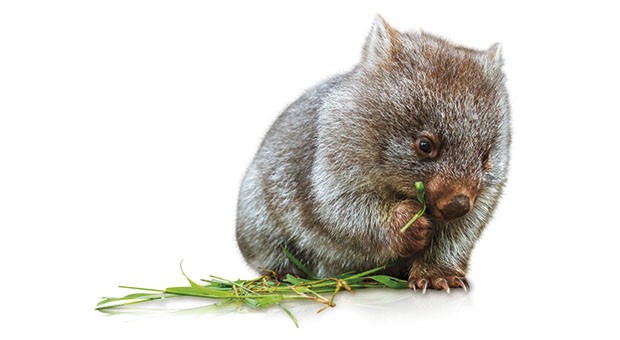Il marsupiale australiano vive sottoterra, si difende col sedere corazzato, ma è a rischio estinzione
Il wombat, in italiano vombato, è un marsupiale che vive nelle foreste, sulle montagne e nelle lande dell’Australia sud-orientale e della Tasmania. Il termine wombat risale alla popolazione degli Eora, gli aborigeni che un tempo vivevano nell’area dell’attuale Sydney.
Riservati e territoriali
Lunghi circa un metro, i vombati sono dotati di zampe tozze e muscolose e una coda molto corta, ma nonostante la corporatura robusta, quando si sentono minacciati riescono a correre fino a quaranta chilometri orari.Passano la maggior parte del loro tempo sottoterra, scavando complessi sistemi di gallerie grazie ai potenti artigli e ai denti frontali simili a quelli dei roditori: incredibilmente gli incisivi di questa specie non smettono mai di crescere nel corso della vita, ma i vombati riescono a mantenerli sempre della stessa lunghezza affilandoli con cortecce e radici. Si avventurano fuori dalle tane quasi esclusivamente per procurarsi del cibo, d’abitudine dopo il crepuscolo, per cui è molto difficile avvistarli.
I vombati difendono strenuamente il proprio territorio, che può estendersi anche per una ventina di ettari, e reagiscono con aggressività quando percepiscono l’arrivo di un intruso. Una caratteristica tipica di questi animali è quella di avere il marsupio rivolto verso il basso, al contrario rispetto agli altri marsupiali; in questo modo, quando scava, la madre non corre il rischio di gettare terra sul proprio piccolo.
Tutte questioni di... sedere!
I principali predatori del wombat sono i dingo e i diavoli della Tasmania, ma la sua forma di difesa sta tutta... nel sedere! Essendo coperto da uno strato spesso di pelle e cartilagine, il vombato utilizza il posteriore come scudo. Quando viene attaccato si rifugia nella buca più vicina, bloccando l’accesso ai predatori con le proprie natiche, che – anche grazie alla coda poco sviluppata – sono molto difficili da mordere o ferire. Ma questo marsupiale ha un'altra caratteristica curiosa, che ha sempre a che fare con il posteriore: gli escrementi a forma di cubo. Tale stranezza pare essere il risultato di un adattamento evolutivo preciso, volto a far sì che le feci non rotolino via ma restino ben ancorate al suolo a segnalare il territorio. Un vombato può produrre in una sola notte fino a cento cubetti di feci, che infatti sono solitamente disposti attorno all’ingresso della tana.
Molti sono gli esperti che si sono interrogati sull’origine della forma a parallelepipedo degli escrementi del vombato, che pare sia connessa alla conformazione dell'ultimo tratto di intestino dell'animale. Esistono tre specie di vombato leggermente diverse tra loro: quello comune, quello dal naso peloso meridionale e quello dal naso peloso settentrionale, che attualmente è a rischio critico di estinzione, considerando che ne restano solo duecentoquaranta esemplari in appena sei chilometri quadrati. Le cause principali sono – come spesso accade – direttamente o indirettamente riconducibili all’azione dell’uomo: la distruzione del loro habitat, la competizione con il bestiame domestico, l’aumento della siccità per effetto dei cambiamenti climatici.
Laura Spataro
The wombat, a mysterious animal...in front and behind!
This Australian marsupial lives underground and defends itself with its armoured rear end but it is at risk of extinction
The wombat is a marsupial which lives in the forest, in the mountains and on the moors in south-eastern Australia and Tasmania. The word wombat derives from the Eora people, aborigines who once lived in the area of modern day Sydney.
Reserved and territorial
Around one metre long, wombats have stocky, muscular paws and a very strong tail but their robust bodies do not stop them from running up to forty kilometres per hour when they feel threatened. They spend most of their time underground, digging complex networks of burrows with their powerful claws and front teeth similar to those of rodents. Incredibly the incisors of this species never stop growing and wombats keep them the same length throughout their lives by sharpening them on bark and roots. They venture out of their burrows almost exclusively to find food, generally after dusk, and it is thus very difficult to catch a glimpse of them.Wombats defend their territory - which can cover as much as twenty hectares - energetically and react aggressively when they sense an intruder.
One of the characteristics of the animal is to keep its pouch facing downwards, in contrast to other marsupials, so as to avoid throwing earth on its cubs when it digs.
It’s all a question of...bottom!
The wombat’s main predators are dingoes and Tasmanian devils but its defensive method is all a matter of its bottom!
Covered with a thick layer of skin and cartilage, the wombat uses its rear end as a shield. When it is attacked it takes refuge in the nearest hole, blocking access to predators with its bottom which is very difficult to bite or injure, also thanks to its short tail.
But this marsupial has a further curious characteristic which is also to do with its bottom: its cube shaped droppings. It would seem that this strange feature is the result of a specific evolutionary process designed to ensure that its faeces do not roll but remain well anchored to the terrain to mark its territory. A wombat can produce up to one hundred cubes of faeces in a single night and these are generally to be found arranged around the entrance to its burrow. Many experts have wondered about the rectangular shape of the wombat’s faeces which would seem to be linked to the shape of its intestines.
There are three species of wombat with slight differences between them: common wombats, southern hairy nosed wombats and northern hairy nosed wombats, which are currently at critical risk of extinction as only two hundred and forty remain in just six square kilometres. The main causes, as is frequently the case, are directly and indirectly related to human habits: the destruction of their habitat, competition with domestic cattle and increases in drought due to climate change.
Traduzione di Viceversa Group
Bergamo - Via Maglio del Rame 19
Per informazioni Tel: 035 4281462
Traduzioni e Interpretariati professionali
Staff multilingue per fiere, congressi, eventi
Corsi di lingue per privati e aziende
















